Listen to This Article:
A serious dedication to the culinary or pastry arts means a commitment to selecting and artfully using an array of professional chef tools.
Like the musician who never stops learning more about her instrument, or the artist who never ceases experimenting with his paint brush, a true culinary artist never stops finding new ways of getting more and more value out of a basic set of tools.
In this article, we’ll take a look at the toolkits Escoffier online culinary students and online baking & pastry students can receive, and explore the ways students can begin understanding how to use their tools in the kitchen.
The Escoffier Toolkit for Online Culinary Students
Upon enrolling in one of Escoffier’s online culinary programs, students receive a standard toolkit containing utensils and tools specific to their program, as well as a chef’s uniform. This kit includes items students may need to get started with a professional culinary education from home.
Official Escoffier Uniform
Depending on their programs, Escoffier students may receive an official uniform boasting the Escoffier logo. Students are expected to wear this uniform while attending classes as a standard of professionalism.
The uniform set includes a chef’s coat, apron, and a skull cap. It’s an honor to don the pristine uniform, and continue the legacy of the chef’s attire.
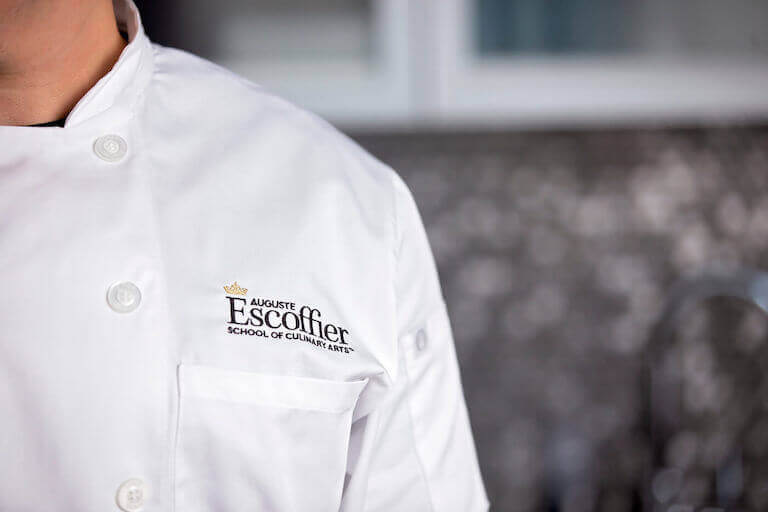
The Escoffier uniform signals excellence and professionalism.
Utensils for Culinary Arts Students
Students enrolled in an online culinary arts diploma or degree program will receive the following utensils and tools in their kit.
- 10” German steel sharpener
- 12” hi-temp spoon
- 14” polyurethane pastry bag
- 3.5” paring knife
- 6” boning knife
- 8” chef’s knife
- Chlorine test strips
- Cutlery tube set
- Digital probe thermometer
- Double zip case
- Escali pico scale
- Mercer ruler
- Plastic bowl scraper
- Y peeler
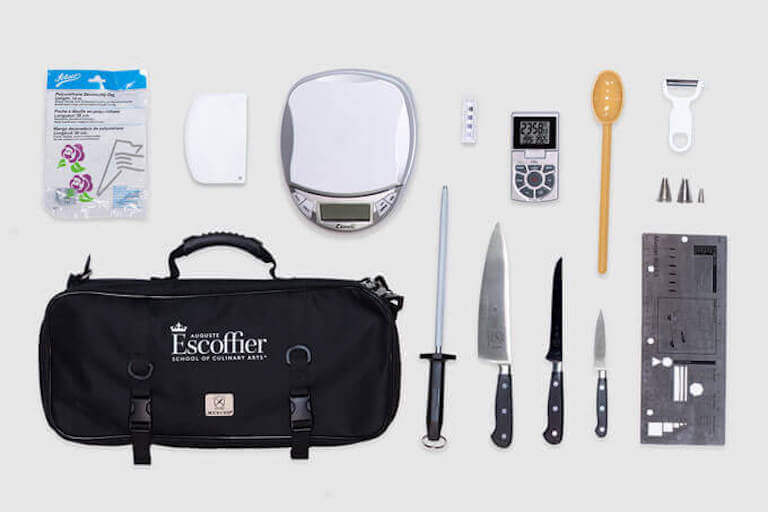
An online culinary arts toolkit.
Utensils for Pastry Arts Students
Students enrolled in the pastry arts online program require a different set of utensils than those in culinary arts programs. The pastry toolkit includes the following unique pieces.
- #907 flower nail tip
- 1” pastry brush
- 10 plain decorating tips
- 10 star decorating tips
- 10” piano wire whip
- 12” wavy edge slicer
- 14” polyurethane pastry bag
- 3.5” paring knife
- 4.25” offset spatula
- 8” chef’s knife
- 8” offset spatula
- Bench scraper
- Chlorine test strips
- Digital probe thermometer
- Double zip case
- Escali pico scale
- Fine zester
- Large scraper (heat resistant)
- Pastry tube set
- Plastic bowl scraper
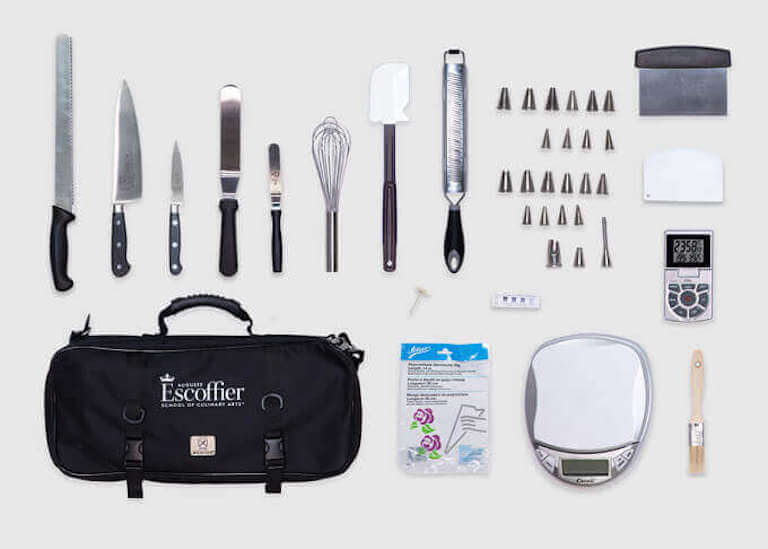
An online pastry arts toolkit.
These tools and utensils allow students to create stunning and decadent pastries following their Chef Instructors’ direction and assignments.
Putting Tools to Use in the Curriculum
So how do students begin to understand how to use their professional chef tools? They practice—a lot! Completing course assignments in their home kitchens and preparing meals for themselves or their families provides students with plenty of opportunities to get a feel for their tools. And by following advice from their Chef Instructors, students can continually improve how effectively they use their tools.
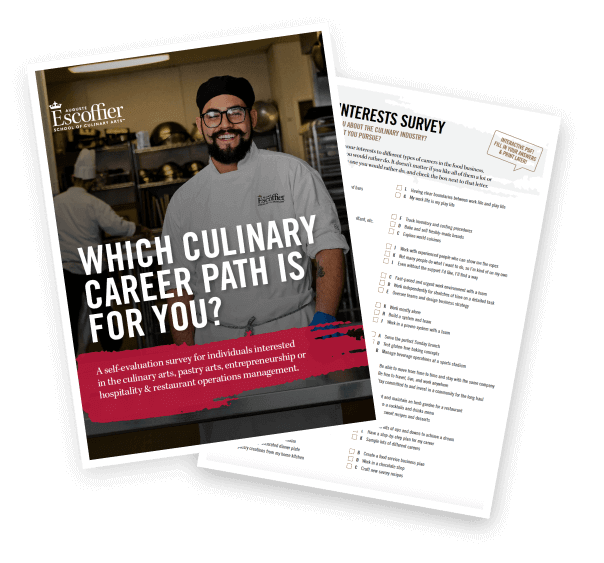
Take the Culinary Career Survey
We’ve compiled a checklist of all of the essential questions into one handy tool: career options, culinary interest surveys, educational opportunities, and more.
The Tools of the Trade
“The tools of your trade or the tools of the trade are the skills, instruments, and other equipment that you need in order to do your job properly.” – Collins Dictionary
For example, in the Culinary Foundations course, students can have the opportunity to practice using the tools that are essential to basic cooking techniques. They may work to understand equipment operation, the use and effect of heat, and seasoning principles. This course also includes fundamental knife skills, cutting techniques, and the concept of mise en place.
As students progress through the curriculum, tools are deployed in more advanced ways to create a variety of dishes.To help you visualize how this progression will look, note these examples.
- Culinary Foundations can provide students with an intro to some of their tools and the opportunity to practice precise chiffonade with a chef’s knife or quickly moving ingredients with a bench scraper.
- The Culinary Arts and Patisserie course might include preparation of hot and cold hors d’oeuvres and breakfast items, so students can develop muscle memory when whipping eggs with a whisk and fine-tune their knife skills
- Exploring other cultures and their dishes is the major premise of the World Cuisines course, and it may provide students with the chance to explore how to select the proper tool when handling new ingredients.
Pastry arts students follow a different curriculum designed to give them plenty of practice with tools specific to their craft. For example, students can have an opportunity to gain an understanding of the proper tools to use for creating tempered chocolate truffles and garnishes in the Confiserie course, or demonstrating an understanding of laminated doughs and puff pastry in the courses focused on artisan baking.
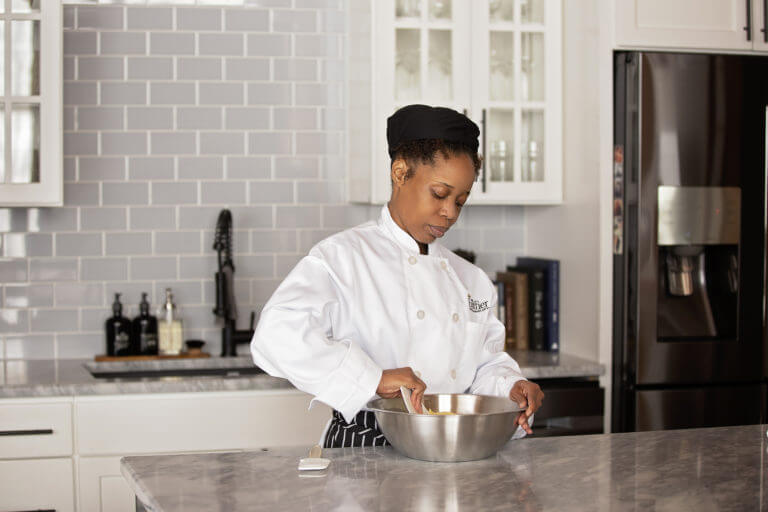
Students work with various tools to gain experience.
Escoffier’s Online Platform: The Perfect Way to Start Using Professional Chef Tools Properly
Since professional chef tools are the fundamental tools of the trade, quality instruction and mentorship can make it easier to learn how to use them properly. Escoffier’s online learning platform and mobile app can give online students a way to submit assignments, track their progress, and interact with their Chef Instructors and classmates.
By documenting their journey with photos and a written narrative, students and Chef Instructors may be able to collaborate on what went well and where students can improve…including the proper use of tools and methods.
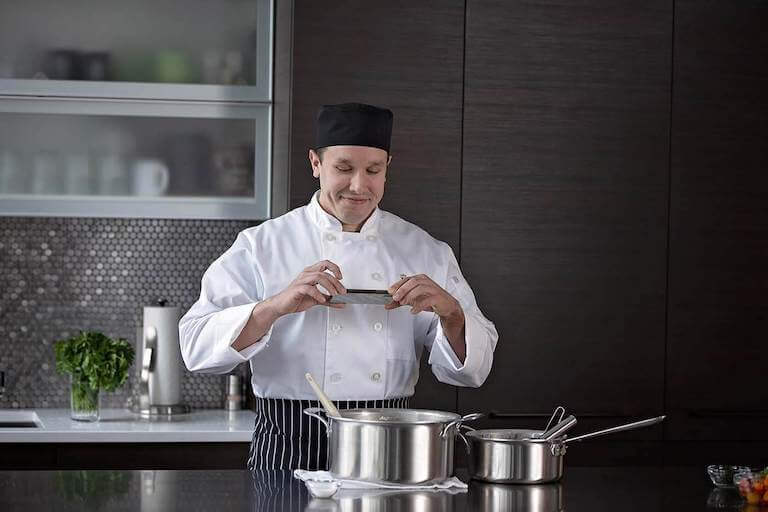
Students document their work and submit it for feedback.
Explore Culinary Tools At Escoffier
No matter how much or little experience you have in the kitchen, understanding the proper use of professional chef tools may be fundamental to a successful career in the food business. If you’re curious or have questions, request more information to find out if Escoffier’s online culinary or pastry arts program is right for you.
“Online is a lot more hands on than people think. My chefs are always right there to help me with any questions I have. And when they grade assignments, they see every step and can help determine what you did right, what you did wrong, and what you need more practice on. You literally have a team of people there for you to help you every step of the way.”*
Brianna Burroughs, Escoffier Online Culinary Arts Student
If you enjoyed this article, read these next:
- Yes, Online Culinary School Works. Here’s How.
- A Day in the Life of an Online Culinary Student
- How Online Pastry School Works
This article was originally published on April 27, 2021, and has since been updated.
*Information may not reflect every student’s experience. Results and outcomes may be based on several factors, such as geographical region or previous experience.

